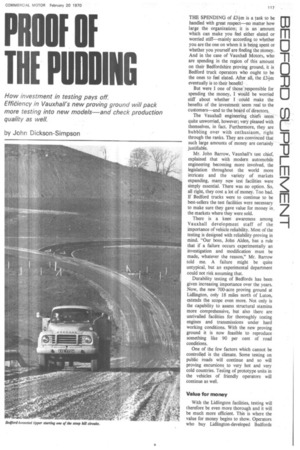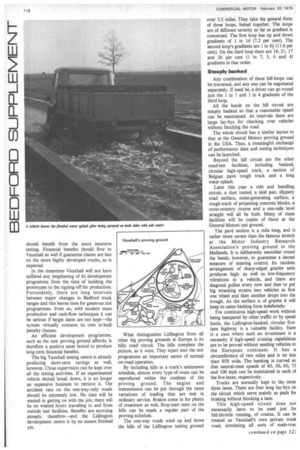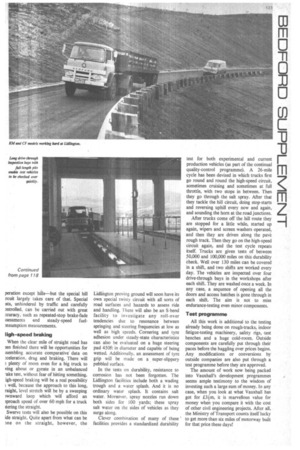PROOF 01 THE PU I DING
Page 119

Page 120

Page 125

If you've noticed an error in this article please click here to report it so we can fix it.
How investment in testing pays off Effidiency in Vauxhall's new proving ground will pack more testing into new models—and check production quality as well.
THE SPENDING of £3-i-m is a task to be handled with great respect—no matter how large the organization; it is an amount which can make you feel either elated or worried stiff—mainly according to whether you are the one on whom it is being spent or whether you yourself are finding the money. And in the case of Vauxhall Motors, who are spending in the region of this amount on their Bedfordshire proving ground, it is Bedford truck operators who ought to be the ones to feel elated. After all, the Dim eventually is to their benefit!
But were I one of those 'responsible for spending the money, I would be worried stiff about whether I could make the benefits of the investment seem real to the customers—and to the board of directors.
The Vauxhall engineering chiefs seem quite unworried, however; very pleased with themselves, in fact. Furthermore, they are bubbling over with enthusiasm, right through the ranks. They are convinced that such large amounts of money are certainly justifiable.
Mr. John Barrow, Vauxhall's test chief, explained that with modern automobile engineering becoming more involved, the legislation throughout the world more intricate and the variety of markets expanding, many new test facilities were simply essential. There was no option. So, all right, they cost a lot of money. Too bad. If Bedford trucks were to continue to be best-sellers the test facilities were necessary to make sure they gave value for money in the markets where they were sold.
There is a keen awareness among Vauxhall development staff of the importance of vehicle reliability. Most of the testing is designed with reliability-proving in mind. "Our boss, John Alden, has a rule that if a failure occurs experimentally an investigation and modification must be made, whatever the reason," Mr. Barrow told me. A failure might be quite untypical, but an experimental department could not risk assuming that.
Durability testing of Bedfords has been given increasing importance over the years. Now, the new 700-acre proving ground at Lidlington, only 18 miles north of Luton, extends the scope even more. Not only is the capability to assess structural stamina more comprehensive, but also there are unrivalled facilities for thoroughly testing engines and transmissions under hard working conditions. With the new proving ground it is now feasible to reproduce something like 90 per cent of road conditions.
One of the few factors which cannot be controlled is the climate. Some testing on public roads will continue and so will proving excursions to very hot and very cold countries. Testing of prototype units in the vehicles of friendly operators will continue as well.
Value for money With the Lidlington facilities, testing will therefore be even more thorough and it will be much more efficient. This is where the value for money begins to show. Operators who buy Lidlington-developed Bedfords should benefit from the more intensive testing. Financial benefits should flow to Vauxhall as well if guarantee claims are less on the more highly developed trucks, as is expected.
In the meantime Vauxhall will not have suffered any lengthening of its development programme from the time of building the prototypes to the signing-off for production. Fortunately, there are long intervals between major changes in Bedford truck ranges and this leaves time for generous test programmes. Even so, with modern mass production and cash-flow techniques it can be serious if target dates are not kept--the system virtually contains its own in-built penalty clauses.
An efficient development programme, such as the new proving ground affords, is therefore a positive asset bound to produce long-term financial benefits.
The big Vauxhall testing centre is already producing short-term savings as well, however. Close supervision can be kept over all the testing activities. If an experimental vehicle should break down, it is no longer an expensive business to retrieve it. The accident rate on the one-way-only roads should be extremely low. No time will be wasted in getting on with the job; there will be no wasted hours travelling to and from outside test facilities. Benefits are accruing already, therefore—and the Lidlington development centre is by no means finished yet. What distinguishes Lidlington from all other big proving grounds in Europe is its hilly road circuit. The hills complete the picture, as it were. They inject into the test programme an important sector of normal on-road operation.
By including hills in a truck's endurance schedule, almost every type of route can be reproduced within the confines of the proving ground. The engine and transmission can be put through the same variations of loading that are met in ordinary service. Brakes come in for plenty of treatment as well. Stop-start tests on the hills can be made a regular part of the proving schedule. The one-way roads wind up 'and down the hills of the Lidlington testing ground over 3.3 miles. They take the general form of three loops, linked together. The loops are of different severity so far as gradient is concerned. The first loop has up and down gradients of 1 in 14 (7.2 per cent). The second loop's gradients are 1 in 8+ (11.6 per cent). On the third loop there are 14, 21, 17 and 26 per cent (1 in 7, 5, 6 and 4) gradients in that order.
Steeply banked
Any combination of these hill-loops can be traversed, and any one can be negotiated separately. If need be, a driver can go round just the 1 in 7 and 1 in 4 gradients of the third loop. All the bends on the hill circuit are steeply banked so that a reasonable speed can be maintained. At intervals there are large lay-bys for checking over vehicles without blocking the road.
The whole circuit has a similar layout to that at the General Motors proving ground in the USA. Thus, a meaningful exchange of performance data and testing techniques can be launched.
Beyond the hill circuit are the other road-test facilities, including banked, circular high-speed track, a section of Belgian pave rough track and a long water-splash.
Later this year a ride and handling circuit, a dust tunnel, a skid pan, slippery road surface, noise-generating surface, a rough-track of projecting concrete blocks, a cross-country course and a one-mile level straight will all be built. Many of these facilities will be copies of those at the General Motors test ground.
The pave section is a mile long, and is rather more severe than the famous stretch at the Motor Industry Research Association's proving ground in the Midlands. It is deliberately smoother round the bends, however, to guarantee a decent measure of steering control. Its random arrangement of sharp-edged granite setts produces highas well as low-frequency vibrations in a vehicle, and there are diagonal gullies every now and then to put big wracking strains into vehicles as first one wheel and then another drops into the trough. As the surface is of granite it will keep its same bashing form indefinitely.
For continuous high-speed work without being hampered by other traffic or by speed limits, the Lidlington-banked, circular fivelane highway is a valuable facility. Here is a case where such an investment is a necessity if high-speed cruising capabilities are to be proved without sending vehicles to the European continent. It has a circumference of two miles and is no less than 85ft wide. The banking is curved so that neutral-steer speeds of 40, 50, 60, 75 and 100 mph can be maintained in each et the five lanes, respectively.
Trucks are normally kept to the inner three lanes. There are four long lay-bys on the circuit which serve mainly as pads for braking without blocking a lane.
This high-speed circuit does noi necessarily have to be used just foi full-throttle running, of course. It can ix treated as Vauxhall's own private truth road, simulating all sorts of main-roa< peration except hills—but the special hill rcuit largely takes care of that. Special :sts, unhindered by traffic and carefully antrolled, can be carried out with great xuracy, such as repeated-stop brake-fade ;sessments and steady-speed fuelHisumption measurements.
ugh-speed braking
When the clear mile of straight road has en finished there will be opportunities for ;sembling accurate comparative data on celeration, drag and braking. There will ! plenty of room even for a big truck to ving about or gyrate in an unbalanced 7ake test, without fear of hitting something. igh-speed braking will be a real possibility ; well, because the approach to this long, raight, level stretch will be by a sweeping )wnward loop which will afford an )proach speed of over 60 mph for a truck 'tering the straight.
Swerve tests will also be possible on this ide straight. Quite apart from what can be me on the straight, however, the Lidlington proving ground will soon have its own special twisty circuit with all sorts of road surfaces and hazards to assess ride and handling. There will also be an S-bend facility to investigate any roll-over tendencies due to resonance between springing and steering frequencies at low as well as high speeds. Cornering and tyre adhesion under steady-state characteristics can also be evaluated on a huge steering pad 45 Oft in diameter and capable of being wetted. Additionally, an assessment of tyre grip will be made on a . super-slippery pebbled surface.
In the tests on durability, resistance to corrosion has not been forgotten. The Lidlington facilities include both a wading trough and a water splash. And it is no ordinary water splash. It contains salt water. Moreover, spray nozzles run down both sides for 100 yards; these spray salt water on the sides of vehicles as they surge along.
Clever combination of many of . these facilities provides a standardized durability test for both experimental and current production vehicles (as part of the continual quality-control programme). A 26-mile cycle has been devised in which trucks first go round and round the high-speed circuit, sometimes cruising and sometimes at full throttle, with two stops in between. Then they go through the salt spray. After that they tackle the hill circuit, doing stop-starts and reversing uphill every now and again, and sounding the horn at the road junctions.
After trucks come off the hill route they are stopped for a little while, started up again, wipers and screen washers operated, and then they are driven along the pave rough track. Then they go on the high-speed circuit again, and the test cycle repeats itself. Trucks are given tests of between 50,000 and 100,000 miles on this durability check. Well over 130 miles can be covered in a shift, and two shifts are worked every day. The vehicles are inspected over four drive-through bays in the workshops after each shift. They are washed once a week. In any case, a sequence of opening all the doors and access hatches is gone through in each shift. The aim is not to miss endurance-testing even minor components.
Test programme
All this work is additional to the testing already being done on rough-tracks, indoor fatigue-testing machinery, safety rigs, .test benches and a huge cold-room. Outside components are carefully put through their paces before the haggling over prices begins. Any modifications or conversions by outside companies are also put through a test programme before they are approved.
The amount of work now being packed into Vauxhall's development programmes seems ample testimony to the wisdom of investing such a large sum of money. In any case, when you look at what Vauxhall has got for £34m, it is marvellous value for money when you compare it with the cost of other civil engineering projects. After all, the Ministry of Transport counts itself lucky to get more than six miles of motorway built for that price these days!














































































































































































































